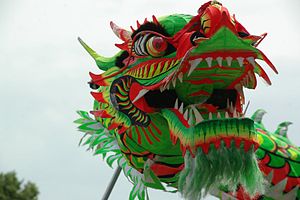
Back Draakdans Afrikaans رقصة التنين ARZ ড্ৰেগন নৃত্য Assamese Əjdaha rəqsi Azerbaijani Dansa del drac Catalan Ū-lṳ̀ng CDO Drachentanz German Danza del dragón Spanish Danse du dragon French ड्रैगन नृत्य Hindi
| Dragon Dance | |||||||
|---|---|---|---|---|---|---|---|
 | |||||||
| Traditional Chinese | 舞龍 | ||||||
| Simplified Chinese | 舞龙 | ||||||
| |||||||
| Alternative Chinese name | |||||||
| Traditional Chinese | 弄龍 | ||||||
| |||||||
Dragon dance (simplified Chinese: 舞龙; traditional Chinese: 舞龍; pinyin: wǔ lóng) is a form of traditional dance and performance in Chinese culture. Like the lion dance, it is most often seen during festive celebrations. The dance is performed by a team of experienced dancers who manipulate a long flexible giant puppet of a dragon using poles positioned at regular intervals along the length of the dragon. The dance team simulates the imagined movements of this river spirit in a sinuous, undulating manner.
The dragon dance is often performed during Chinese New Year. Chinese dragon(s) is a symbol of China's culture, and they are believed to bring good luck to people, therefore the longer the dragon is in the dance, the more luck it will bring to the community.[1] The dragons are believed to possess qualities that include great power, dignity, fertility, wisdom and auspiciousness. The appearance of a dragon is both fearsome and bold but it has a benevolent disposition, and it was an emblem to represent imperial authority. The movements in a performance traditionally symbolize the power and dignity of the dragon.[citation needed]
- ^ "Dragon Dance". Cultural China. Archived from the original on 2014-06-12.